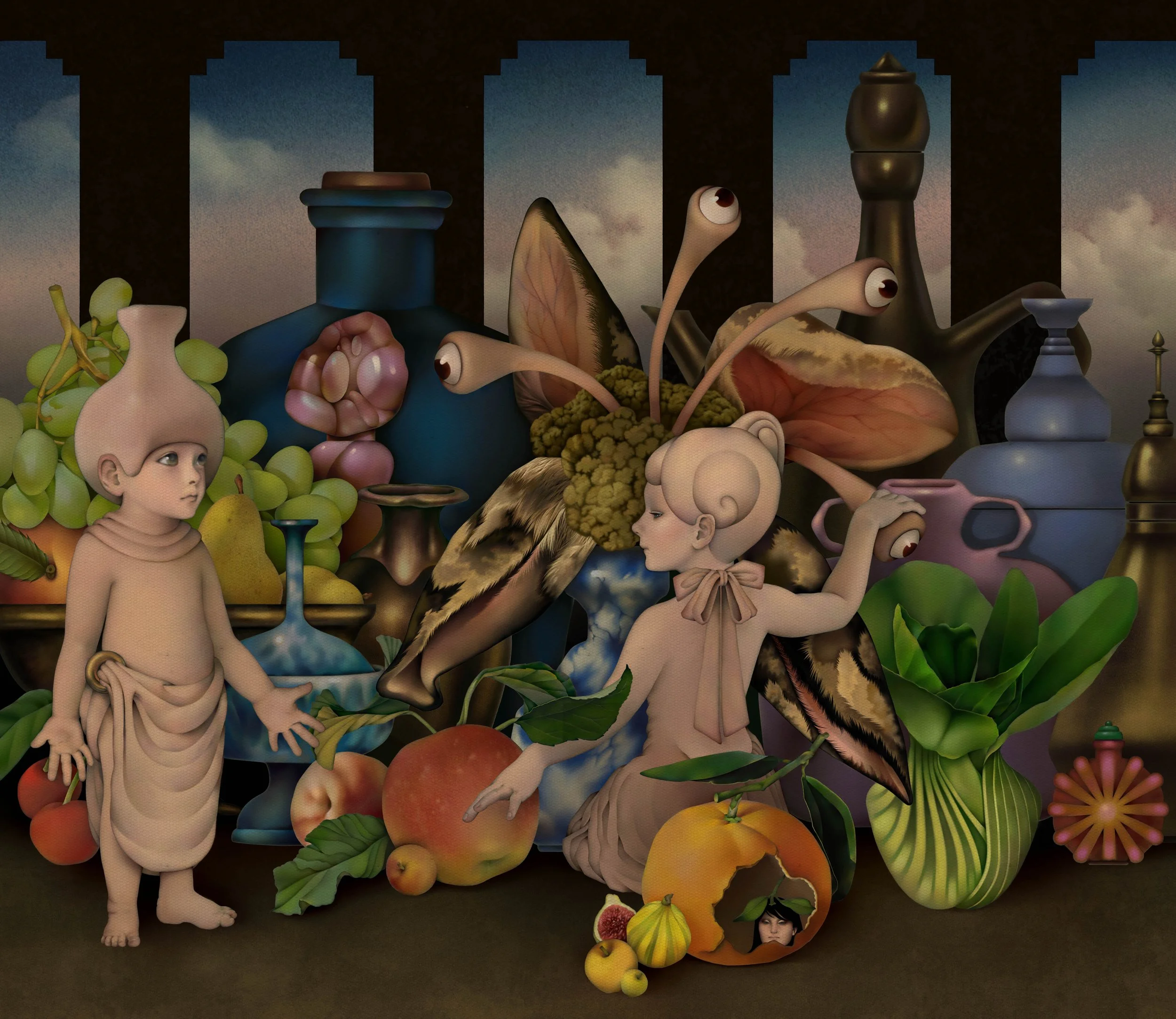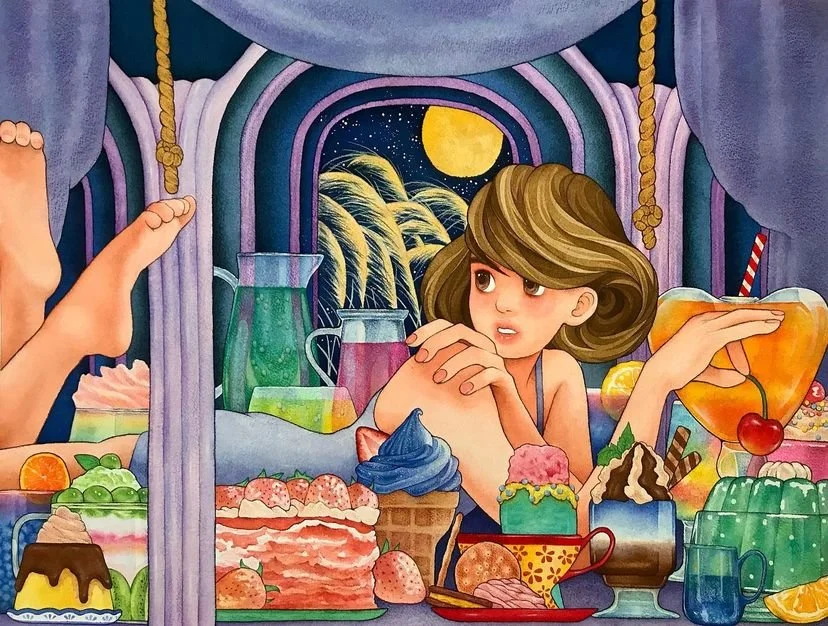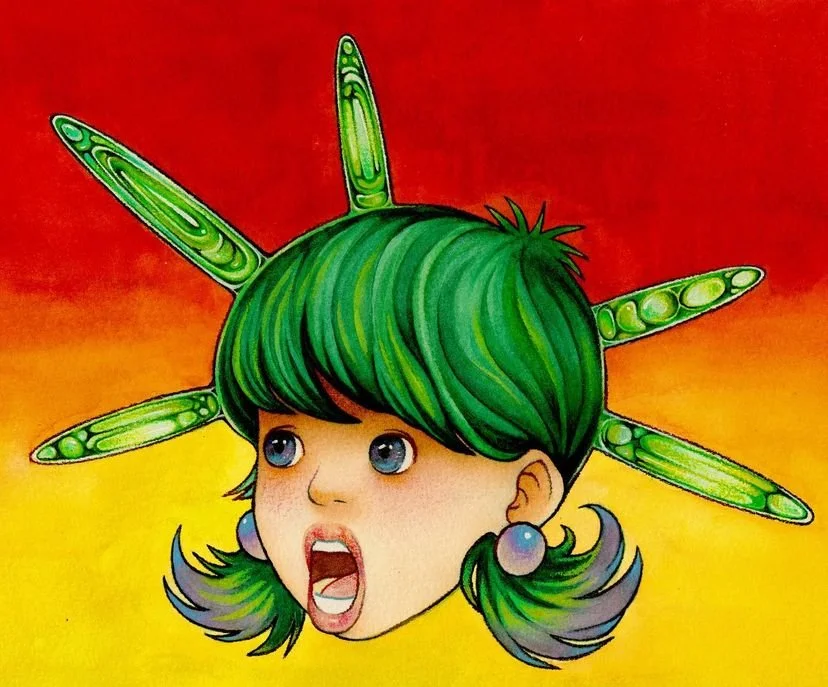When Failure Becomes Freedom: Meet Artist Jin Liu
By Cansu Peker
Jin Liu is an award-winning visual artist and illustrator from China. Drawn to image-making from an early age by the illustrated books of her childhood, she developed a strong visual sense that later guided her studies in Fine Arts at the Savannah College of Art and Design (SCAD). Her work spans a variety of media and approaches, always marked by rich color palettes, symbolic compositions, and emotional depth. Influenced by Maxfield Parrish, Jin brings both expressive feeling and formal clarity to every piece she creates.
Her art has been recognized internationally through exhibitions and publications. She has been featured in Artistonish Magazine, Create! Magazine & AQ, and Divide Magazine, appearing on both the front and back covers of Issue 13. Jin was also named Artist of the Month by the Circle Foundation for the Arts and selected as a winner in American Illustration 43 and AI-AP 44, reflecting her growing presence in the global illustration community.
We asked Jin about her art, creative process, and inspirations.
Can you tell us about your background as a digital artist? How did you get started in this field?
I graduated in 2021 from the Savannah College of Art and Design (SCAD) with a major in Textile Design. Toward the end of my studies, I realized that what I truly loved was illustration and painting. So, after graduation, I began creating my own works and started exploring and developing my personal style.
Your love for art began with childhood book illustrations — do you remember a specific image or book that made a big impact on you?
One picture book that left a lasting impression on me was The Little Mermaid, illustrated by British artist Christian Birmingham. That book revealed to me the emotional power of imagery before I even understood what illustration or painting really meant. I already knew the story so well that I found it uninteresting — until one day I stumbled upon Birmingham’s version in a bookstore. When I opened it, the illustrations were so mesmerizing that they made the familiar story feel entirely new, as if I were experiencing it for the first time. That moment quietly planted the seed of a thought: I want to draw.
Are there any themes or stories you’re currently exploring that feel exciting or challenging?
Dreams and fantasy have always been central to my work, and I want to keep developing those themes in deeper and more nuanced ways. They give me a framework to build alternate realities—spaces where I can stretch logic, shift time, and experiment with symbolism. Lately, I’ve started weaving in quiet reflections on everyday life and drawing inspiration from my ongoing studies in mysticism. That’s pushed me to think more about how the subtle textures of real life—its silences, repetitions, and absurdities—can coexist with the surreal.
The biggest challenge, and also the most exciting part, is finding a way to integrate these different elements into a single, coherent visual language. I’m constantly navigating the balance between complexity and clarity—wanting the work to feel layered without becoming chaotic. I want to create images that are emotionally dense yet breathable, strange but still resonant. That ongoing process of refinement keeps me curious, and it’s what makes the work feel alive to me.
How did studying at SCAD influence your growth as an artist, especially as you explored different mediums and styles?
While studying at SCAD, I had the chance to experiment with a wide range of materials and techniques through various courses. Every new material or process sparked fresh inspiration and gave me valuable experience combining different media. The tactile experiences I gained there helped feed my desire — and gave me the tools — to translate those sensations into visual expression. I feel like my time at SCAD gave me my most precious asset: ambition. It turned me into a “hungry artist” in the best possible sense.
How did Maxfield Parrish's work shape your artistic voice, and what elements of his style do you find yourself most drawn to?
What draws me most to Maxfield Parrish isn’t just his technical mastery of light, texture, and space, but the unique tone that runs through his work—a kind of theatrical stillness. There’s something both intimate and distant about his compositions, as if he’s fully immersed in his imaginary worlds while simultaneously observing them from the outside. His images seem to flirt with fantasy, yet always retain a deliberate self-awareness.
That emotional and formal tension has had a deep impact on how I think about my own work. Parrish taught me that you don’t need to dominate an image to give it power. Sometimes, the most profound moments in a painting happen when you step back—when you let the image lead and allow space for things to unfold on their own terms. That delicate negotiation between affection and detachment has become a foundational part of how I engage with my practice.
If someone’s seeing your work for the first time, what do you hope they take away from it emotionally or visually?
I really don’t mind if someone’s first response is just, “This looks good.” Visual appeal can be a beautiful entry point. But what I truly hope is that, as they spend more time with the piece, they begin to feel something less immediate and more immersive—like they’re drifting gently into a space between memory and imagination.
I often think of viewing art as a kind of silent exchange. If my fantasy can stir a ripple of fantasy in someone else—if it feels like we’re briefly passing an invisible ball back and forth—that’s a moment of real connection. In that sense, the work isn’t just a static object; it becomes a shared pause, a place for thought to hover. If someone walks away feeling slightly transported or inwardly nudged, then the piece has done what I hoped it would.
Can you tell us about some of your favorite pieces or a past or upcoming project? What makes them special to you?
Lately I’ve been working on a series that I deliberately defined as “works that are destined to fail.” This phrase might sound pessimistic at first, but for me, it’s an intentional strategy — a way to give myself permission to disrupt the rigid expectations I used to place on my own work. I’ve always had a strong perfectionist streak, and while that has pushed me to refine my craft, it has also made it difficult to take risks or embrace uncertainty in the creative process.
By labeling these pieces as “failures” from the outset, I create a space where I can experiment freely, without the pressure to make something polished or resolved. I intentionally incorporate elements of imbalance, fragmentation, or incompletion — not as mistakes to be corrected, but as emotional cues that reflect a more honest internal state. The process is messy and uncomfortable at times, but that’s precisely the point. I’m learning to tolerate contradiction and loosen control. This series has become a deeply personal turning point for me — not just in terms of aesthetics, but also in how I relate to my own inner world. It allows me to question what “success” in art even means, and to find value in works that feel unresolved, vulnerable, or ambiguous. In that sense, these so-called “failures” are actually teaching me more about what I want from my practice than any of my more “successful” works ever have.
What is a profound childhood memory?
I attended a boarding school in elementary school and lived with my classmates for seven years. One memory that really stayed with me is the last day of sixth grade, our graduation day. I cried the whole way from school to home. It was the first time in my life that I truly understood what it meant to say goodbye — and it took me a long time to process and accept it.
What is a fun fact about you?
I like to dip every bite of my popsicle in hot water before eating it.






















